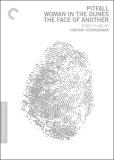| Reviews & Columns |
|
Reviews DVD TV on DVD Blu-ray 4K UHD International DVDs In Theaters Reviews by Studio Video Games Features Collector Series DVDs Easter Egg Database Interviews DVD Talk Radio Feature Articles Columns Anime Talk DVD Savant Horror DVDs The M.O.D. Squad Art House HD Talk Silent DVD
|
DVD Talk Forum |
|
|
| Resources |
|
DVD Price Search Customer Service #'s RCE Info Links |
|
Columns
|
|
|
Three Films by Hiroshi Teshigahara (Pitfall / Woman in the Dunes / The Face of Another) - Criterion Collection
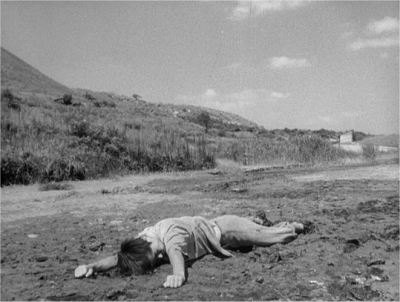
As one of Japan's most revered avant-garde filmmakers, Hiroshi Teshigahara chose an interesting path during a life rich with opportunity. As the son of Sofu Teshigahara---artist and founder of the prestigious Sogestu school---the young man showed a natural interest in painting and sculpture, though his mind gradually pulled him towards the world of cinema. Collaborating with author Kobo Abe and composer Toru Takemitsu, Teshigahara and company created a handful of unique and stylish films that helped push international cinema one step further. Though the first three of these films---Pitfall, Woman in the Dunes and The Face of Another---are completely devoid of color, the dramatic visuals create haunting, rich atmospheres nonetheless.
Pitfall (1962, at top) tells the story of a miner whose life is taken by a mysterious man in a white suit. He soon re-enters the world as a ghost, full of questions about why he was suddenly killed en route to a new job. The man in white pays off our only witness, a tired woman who works in an all-but-abandoned village nearby. Another ghost informs the miner that his curiosity will get him nowhere; this holds especially true, since ghosts can't interact with those still among the living. As the miner's young son walks aimlessly around the village and surrounding area---strangely devoid of emotion, even after the death of his father----the story unravels as the murder investigation is set in motion. Obviously, it won't be an open-and-shut case.
Compact and surprisingly insular, Pitfall shows the work of collaborators who have already found a steady rhythm. The film's gripping and creative visuals easily hold our attention, employing the use of striking camera techniques and a few early "special effects" to keep things interesting. Though it's most certainly set in modern times, Pitfall's haunting and timeless landscape gives it a true supernatural quality; additionally, the story's unconventional structure creates a tense but deliberate pace. Interestingly enough, the film raises plenty of questions but doesn't aim to answer them all, which will only prove frustrating to those who like everything tied up neatly. Though Teshigahara and company will tighten their formula in the years to come, Pitfall's urgency and intimate charm makes it a strong debut in its own right. (Film Rating: 4/5)

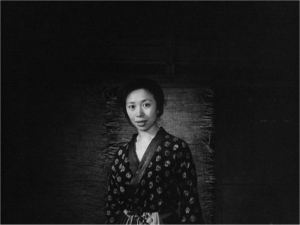
Woman in the Dunes (1964, above) stands tall as Teshigahara's most acclaimed film, and for good reason. Though only the second formal collaboration between the three artists, this tale of man vs. woman vs. nature shows a marked improvement in execution and accessibility. Based on the best-selling novel by Abe, Woman in the Dunes follows an amateur entomologist as he scours the desert for rare insects. After missing the last bus back to Tokyo, the man is invited to stay the night in a nearby village. The "authorities" (for lack of a better term) lead him to the home of a young widow, who lives at the bottom of a deep sand dune accessible only by a rope ladder. Initially grateful for the hospitality, the man soon discovers that he's trapped in his new environment after the ladder disappears. The woman whittles her time away by shoveling the sand that falls from above; otherwise, her rickety hut would eventually be buried. Reluctant to adjust himself to this drastic environmental change, the man must choose between stubbornness and compliance.
Of Teshigahara's three films included here, Woman in the Dunes asks the biggest and most compelling questions. It's almost dauntingly long at 148 minutes---not to mention that most of the film takes place in extremely close quarters---yet the story's raw power and emotion carries the weight completely. We get a sense of the man's predicament almost immediately: trapped along with him, this oddly plausible scenario represents any obstacle that we reluctantly attempt to dig around. Whether they're working together or butting heads, one thing's for certain: the man and his new "wife" (again, for lack of a better term) remain in general seclusion from the rest of the village above. Aside from a weekly delivery of rations and other small moments of interaction, their contact with the outside world is completely sealed off. The years tick by as the man and woman fight with the sand that threatens to bury them, just as it buried her child and former husband.
Perhaps the most linear of Teshigahara's films, Woman in the Dunes still manages to greatly impress with detailed thematic layers and a dense, foreboding atmosphere. It's perhaps the most timeless of the three, due in part to slightly more down-to-earth visuals and a deceptively simple appeal. Quite simply, Woman in the Dunes offers a perfect pairing of style, drama and symbolism that hasn't aged a bit. (Film Rating: 5/5)
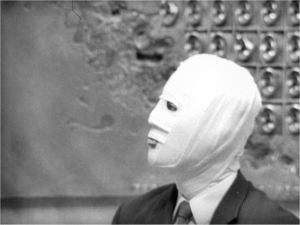
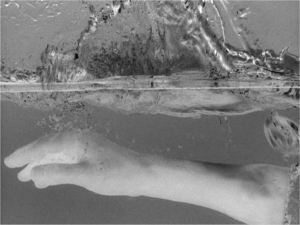
The Face of Another (1966, above) is certainly the most modern of the three, at least on the surface. Shifting to a completely urban landscape, we're introduced to a man whose face has been horribly disfigured by an industrial accident. His bandaged appearance can't help but attract attention, whether it's from total strangers, co-workers or the man's own wife; not surprisingly, he quickly becomes bitter and self-centered. Eventually, the man's psychiatrist proposes a bold medical experiment: a mask will be molded from the facial features of a total stranger, creating a new identity and a new air of confidence for the suffering victim. After hatching a selfish scheme to win back his wife's affection, the man's dual identity creates unexpected new problems during everyday life.
Though our summary paints The Face of Another as a bloated episode of The Twilight Zone, the precision employed by Teshigahara and company gives us plenty to chew on. Oddly enough, this sci-fi tinted tale was discarded by most critics after the unanimous praise for Woman in the Dunes---and though it's not quite as polished as its older brother, there's more than enough here to make The Face of Another a thought-provoking and spellbinding film. Our protagonist remains almost frustratingly bitter at first, paving the way for a drastic transformation that seems perfectly natural. Luckily, the end result isn't cloying or preachy; in fact, the film's refreshingly dark and twisted conclusion holds everything together nicely. It's undoubtedly the most underrated of the three, but make no mistake about it: The Face of Another is completely focused and visually ambitious in its own right. (Film Rating: 4.5/5)
Three Films by Hiroshi Teshigahara collects Pitfall, Woman in the Dunes and The Face of Another in one handy boxed set, pairing the trio with strong technical presentations, a bonus disc and a thick booklet filled with retrospective comments. Those new to the director should consider this an accessible collection of Japanese avant-garde films, while die-hard Teshigahara fans will simply be glad to have solid Region 1 treatments of his finest work. Let's take a closer look, shall we?
Presented in their original 1.33:1 aspect ratios, all three films look quite good for their age. The black-and-white transfers are uniformly rich in detail and contrast, boasting deep blacks and natural contrast. Hints of dirt and debris can be seen on occasion, but it's almost impossible to complain overall. NOTE: As with a few other recent releases, Criterion has chosen to window-box all three films, creating a black border to compensate for television overscan (a larger, uncropped screen capture can be seen here). Though this window-boxing will only prove to be a mild problem for some viewers, it's certainly worth mentioning.
The Dolby Digital mono mixes for all three are uniformly good; though the high ends often sound a bit thin, this is undoubtedly a source material issue. Dialogue is typically clear and well-rendered, while Takemitsu's striking music cues stand in good contrast. Optional English subtitles have been included during the main features and bonus materials, though only for translation purposes.
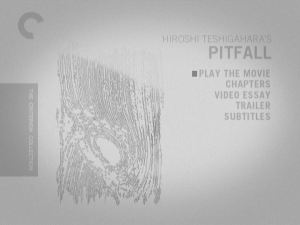
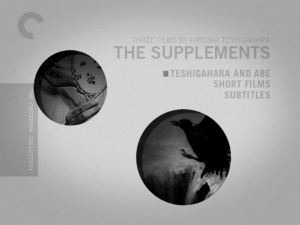
The bonus disc leads off with "Teshigahara and Abe" (34:51, presented in 1.78:1 anamorphic widescreen), a retrospective look at the collaboration between the director and author. Featuring comments from film professor Richard Pena, film scholars Donald Richie and Tadao Sato, set designer Arata Isozaki, screenwriter John Nathan and producer Noriko Nomura, "Teshigahara and Abe" offers proof of the artists' legacy and creative contributions. Though portions of this piece are a bit on the dry side, those who appreciate the films of Teshigahara (below left) should find them informative.
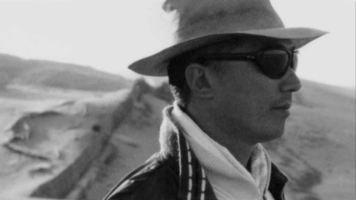
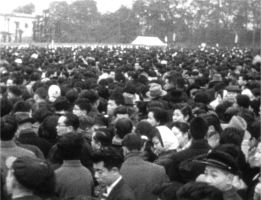
Also on board the fourth disc is a collection of early Short Films by Teshigahara, all filmed in black and white over a 12-year period. Hokusai (1953, 23 minutes) offers a look at the famed wood block artist of the same name; Ikebana (1956, 32 minutes) pays tribute to the director's father and the Sogetsu school; Tokyo 1958 (24 minutes, above right) provides a playful tribute to the bustling city, and Ako (1965, 29 minutes) follows a young girl on a carefree but frightening night out. All but the last entry are in fairly rough shape, but they offer strong glimpses of Teshigahara's skill and creativity behind the camera. Like the main features, all of these shorts are presented in their original 1.33:1 aspect ratios and include mono soundtracks.
Also tucked inside is a 64-page Booklet featuring essays by filmmaker Peter Grilli, author Howard Hampton, author/translator Audie Bock and James Quandt, as well as a vintage interview with Teshigahara translated from a French publication. All things considered, there's a solid amount of material here for the asking price.
These may be an acquired taste, but those who appreciate visual flair and solid storytelling should certainly enjoy Three Films by Hiroshi Teshigahara. Though Pitfall, Woman in the Dunes and The Face of Another were all released within a five-year period and share certain thematic elements, they each stand tall as unique tales of blurred identity, mortality and social awareness. Criterion's respectful treatment of these films should please Teshigahara fans, boasting strong technical presentations and a fine assortment of bonus features...with a reasonable price tag, at least on the Criterion scale. All things considered, there's plenty here to appreciate and enjoy through repeat viewings and thoughtful analysis. Three Films by Hiroshi Teshigahara comes very Highly Recommended.
Randy Miller III is an affable office monkey based in Harrisburg, PA. He also does freelance graphic design projects and works in a local gallery. When he's not doing that, he enjoys slacking off, second-guessing himself and writing things in third person.
|
| Popular Reviews |
| Sponsored Links |
|
|
| Sponsored Links |
|
|
| Release List | Reviews | Shop | Newsletter | Forum | DVD Giveaways | Blu-Ray | Advertise |
|
Copyright 2024 DVDTalk.com All Rights Reserved. Legal Info, Privacy Policy, Terms of Use,
Manage Preferences,
Your Privacy Choices | |||||||









